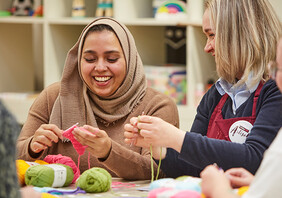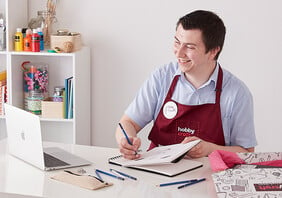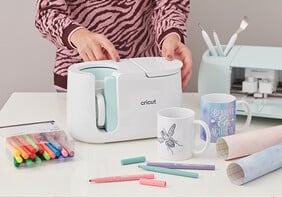A Beginner's Guide to Resin
Follow this step-by-step guide to create a long-lasting resin décor piece which is sure to impress all of your friends and family!
Perfect for beginners and experienced crafters alike, this project is ideal to inspire you and to introduce you to a different approach when working with resin.
Warning: You will need to work in a well-ventilated area while working with resin. You will also need to wear a respirator mask and wear disposable gloves.
***Please note: This is a decorative project and the completed wooden board SHOULD NOT be used for chopping or serving food on.***
*** Instructions included within the Pebeo Gedeo Bio-Based Crystal Resin should be read and fully understood before commencing this, or any resin project using this product ***
You will need
You Will Need
* Clear Resin
* Wooden Slab
* Clear Gesso
* Wooden Craft Sticks
* Heat Tool
* Pipettes
* Frogtape
* Fluid Pigments (we've used white and a variety of blue shades)
* Biodegradable Glitter - Gold, White and Orange
* Gold Gilding Flakes
* Mini White Diamond Table Scatter
* Paper Cups
* Nitrile Gloves
How To Make
Make sure you wear gloves and a mask for safety measures.
Cover the work surface with a protective table cover to help to prevent damage. Prepare all equipment before you start making.
Have something underneath the cutting board to lift it faway rom the table and prevent it getting stuck once the resin has dried, I've used sqaure dowels.
Apply Frogtape to the back of the wooden board, this will help keep the back clean throughout the process.
When using resin on a wooden surface it must first be sealed to help prevent the resin soaking into the wood, this can be done using a clear gesso - make sure this has dried completely before applying the resin.
Crush the crystals with a hammer to make it look more realistic on the finished resin piece. Make sure you prepare of handful of the crystals.
Top Tip: When you're crushing table scatter diamonds, make sure you do so outside on a clean and smooth surface, and cover them with a piece of fabric or cloth.



For the resin mixture, use the measuring spoons supplied in the resin box kit. For this specific brand, it is recommended to use 2 parts of resin (bottle A), to 1 part of hardener (bottle B).
Pour 20ml of resin into one of the measuring cups and pour 10ml of hardener into the other. Take a clean paper cup, pour 20ml of resin into it and then pour the hardener on top of it. Mix it with the wooden craft stick for about 4-5 minutes. The mixing stage is key, mix it gently and thoroughly.
Prepare your glitter in a clean paper cup. Mix the white and gold glitter with the Brian Clegg gold and orange glitter together. Try to pour a similar amount of each glitter into the cup so that you have roughly ¼ of glitter in the cup. Pour the prepared resin on the glitter and mix.
You should end up with quite a thick mixture. Use a craft stick to help yourself when pouring the mixture onto the primed wooden board.
Top Tip: The most common beginner's mistake is not reading the instructions and not following the measurements. Every resin is different, and the instructions are there to help your project to succeed.





You can use the same cup you used before to prepare more resin. Prepare another mixture, using the same measurements as before.
Take a new paper cup and pour all of your crushed crystals into it. Take your resin mixture and pour 2/3 of this mixture on the crystals and mix it using a craft stick. You should end up with quite thick mixture. With a help of a craft stick pour the mixture on the wooden board alongside the glitter.
Top Tip: Make sure you don't leave the resin to sit in the cup too long after mixing it. When the resin and hardener are mixed and left for a longer period of time, it could start curing and eventually permanently cure in the cup.



Take the rest of your resin mixture and pour in some gold flakes, mix, and pour it on the wooden board on the other side of the glitter.
Leave to set and harden for 24 hours.
Top Tip: Make sure that your workplace isn't disturbed while the resin is hardening for at least 24 hours. Moving the wooden board while the resin is hardening may disturb it and cause imperfections on the project.



After 24 hours, the resin should be completely hardened.
Make another batch of resin, as per previous instructions. Split your mixture in half between two clean cups. Take some cobalt coloured fluid pigment with a pipette and put three to four drops into one of the cups, mix it with a craft stick until the colour is mixed in with a resin. Take some blue fluid pigment with a pipette and put three to four drops into the other resin cup and mix it. Put these cups aside, you will need them very soon.
Make up another batch of resin and use a pipette to put three to four drops of another blue colour pigment into the mixture and mix.
Start pouring the cobalt mixture alongside the clear resin with gold flakes. Don't pour all of the mixture, leave some for the other side of the board next to the crystals. Then, take some of the blue mixture and pour all of it alongside the cobalt blue, use a craft stick to connect them.
Then take the final blue mixture and fill in the rest of the corner. Make sure you don't use all of it because you will need it for the other side of the board.
Top Tip: Use a craft stick to help spread the resin evenly across the wooden board.




Take the rest of the cobalt mixture and pour it along the other side of the crystals.
Then pour the rest of the final blue mixture to fill in the rest of the board.


Before the resin hardens, prepare a new resin mixture. Split it in half between two clean cups. Use a pipette to put three to four drops of white fluid pigments into one of the cups, mixing it with a craft stick until the colour is mixed in with the resin.
Pour the white colour resin onto the board - use a craft stick to help divide the resin when you pour. Don't use all of it, keep a little bit for the last step.
Take a heat gun and start moving it across the wooden board to form the pattern. The heat gun will also help to get rid of any unwanted bubbles in the resin. For this specific project, the heat gun will help to form the ocean waves.


Take the paper cup with the clear resin in and pour it alongside the gold flakes. Then, pour some of the clear resin in between the white resin on the board, focussing on the parts which look like white blobs. Take the fluid pigments, and add a drop of blue in every place you poured clear resin.
Move the heat gun across the cutting board to form the pattern.
Next, use the rest of the white pigment where you think you need to add a little bit of colour variation to your board.
Use a heat gun once more to move the resin into your desired position.
Once happy, leave everything to harden for 24 – 48 hours.




When the resin is hardened, take a heat gun, and heat the back of the cutting board. The heat gun will help to loosen the glue in the tape, and it will be easier to peel it off.
After you remove the tape, you can paint the back in a dark blue colour if desired.



Your resin wooden board is now ready to display in your home!













